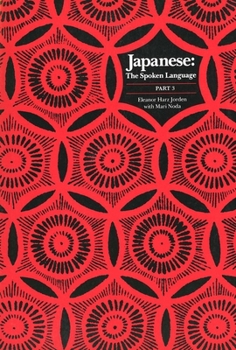Japanese, the Spoken Language: Part 3
Select Format
Select Condition 
Book Overview
This third book of Japanese: The Spoken Language completes a course in modern spoken Japanese that teaches current usage through drills and functional exchanges. The series is entirely romanized.... This description may be from another edition of this product.
Format:Paperback
Language:English
ISBN:0300041918
ISBN13:9780300041910
Release Date:September 1990
Publisher:Yale University Press
Length:416 Pages
Weight:1.25 lbs.
Dimensions:0.7" x 7.2" x 10.1"
Customer Reviews
4 ratings
Great tool for understanding the logic behind the language, however...
Published by Thriftbooks.com User , 18 years ago
As a student taking Japanese in a well-known University that uses the JSL series in its Spoken Language track, this book has become my CRUCH in speaking Japanese. It uses conversations as models to learn from, drills to teach you ways to utilize your new vocabulary and grammar tools, a listening section and translation section (unfortunately without an answer key). The most helpful aspect of the book though are the in-depth grammar explanations; they really help you internalize the meanings and usages of honorifics, conjugations, special words and compounds, speech styles (careful/casual, direct/distal, gentle/blunt...) and so forth. The idea is to help you learn to create these sentences yourself, to the point where it seems natural (although this ideal cannot be achieved without an extended stay in Japan), or at least to the point where you will know the right thing to say in certain social contexts. While the grammar explanations are stellar and offer students a chance to construct new sentences through logic (a very linguistical approach to language-learning), I have found some problems with the series: 1) It's all in romaaji. Let's face it. When you go to Japan, almost everything will be in evil but beautiful scribbles called 'kanji' -- even with JWL - the written language accompaniment - you won't even have the reading capability of a 1st grader. 2) You NEED a GOOD teacher to help you through the series. I did the entire third book myself (by far the most difficult) and I didn't learn it nearly as well as I learned the previous lessons. 3) The slow but exponential learning curve. Things won't "click" until you're more than half-way through the series. There are 30 lessons and around lesson 19 I was able to start constructing complex thoughts in a managable time-frame. However, after that I could start to have basic conversations pertaining to everyday life. 4) This series was originally written for DIPLOMATS during Japan's bubble-economy era, and it really shows. You learn American Consulate in Lesson 7 and air in Lesson 30. Subsequently, you're language will be EXTREMELY formal and stiff compared to today's standards, but it's better to be polite than rude, right? Moreover, slight problem, a few words here and there are outdated (ie Monbusho should be Monbukagakusho, or Monkasho for short). 5) Although the grammar explanations are great, you will probably need a tool to fully understand it... I suggest google-ing Tae Kim's Japanese page. Amazing. In response to the 'huji' review: Jorden has a very good reason for changing a couple spellings for consistency's sake. It will limit the number of exceptions to the already-overloaded conjugation rules. Just deal with it. English has 37 vowel sounds and only 5 vowels! Conclusion: If you're learning this in a class-setting, I say go for it, but still make sure that you're getting a good bit of writing in on your own; luckily, there's a writing portion added to our class. If you're attempti
doumo
Published by Thriftbooks.com User , 19 years ago
Such a simple little word "doumo". Yet when I came to Japan 13 and a bit years ago it started to bug me. Why? Well becasue I knew that it meant "thank you"- everyone knows that right? But the strange thing was that as my ears became more attuned to what people around me were saying, I realized that they were using "doumo" in sometimes very strange ways. When they greeted one another or parted for example. So I thought- well maybe they just use "thank-you" somewhat more broadly than we do in English. But then you hear things like "doumo henn" and "doumo omoshiroi". What on Earth is that all about? So I went to the bookshops and checked every Japanese text I could find and all agreed that "doumo" means thank-you. Seems everyone knew that except for the Japanese. Some time later I chanced upon a copy of JSL and, never having seen it before, looked to see what it had to say about "doumo". Lo and behold- there it was. A simple account that explained all the seemingly disconected uses of "doumo" that I had heard. The series provides plenty of other similarly insightful accounts of Japanese usage that assist with the process of learning to manipulate the language at a fine-grained level. It gets four stars instead of 5 as there is a lack of practice with extended sequences and the recording quality of the tapes is poor.
Superior conclusion of 3-volume text series.
Published by Thriftbooks.com User , 25 years ago
J.S.L.III, like the preceding two volumes, is designed for learners seeking a thorough foundation in the culturally-appropriate use of Japanese by foreigners (i.e., non-native Japanese) in Japan. In its examples and exercises, it uses authentic "real life" Japanese rather than the artificially contrived sentences so often found in foreign language texts. This text series is definitely not for the casual language dabbler.
Chemistry Professor At It Again
Published by Thriftbooks.com User , 26 years ago
How to resolve the twin conflicts this third book of the series presents? While on one hand it is chock-full of appropriate and useful information for intermediate students of the Japanese language (as are the other two volumes in the series), its explanation of the intricacies of the language read like passages from a third-year collegiate chemistry text. Buyer beware-- there are better books out there.






